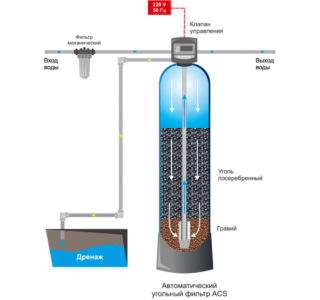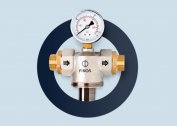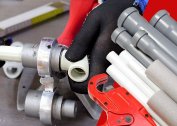Tap water requires high-quality after-treatment. For this purpose, often use different settings. One of the most popular is a flowing carbon filter for water. When a liquid passes through it, all impurities dissolved in the medium are adsorbed. Moreover, viruses, bacteria, and organic substances are also removed from the treated water.
Purpose and scope
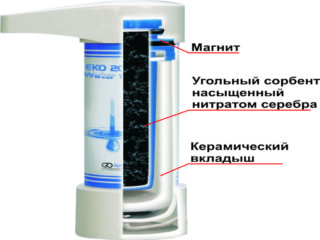 The main task of the coal plant is to clean the liquid from dissolved impurities, odor. Use such filters in the following industries:
The main task of the coal plant is to clean the liquid from dissolved impurities, odor. Use such filters in the following industries:
- home use (tertiary treatment of tap water);
- treatment of effluents in VOCs;
- water treatment before supplying the resource to the highway;
- liquid cleaning in aquariums.
For industrial purposes, coal-based plants are rarely used, since backfill does not cope with large volumes of the processed medium and requires frequent replacement.
Types of filters, principle of operation and device
The basis of the carbon filter is granules of such substances:
- activated charcoal - helps to remove chlorine, suspended particles, ozone, fats;
- aluminum silicate - removes colloidal particles;
- coal - fights phenols, pesticides, odors;
- Coconut charcoal - eliminates organic matter, chlorine from water, improving its quality characteristics;
- natural zeolite - works against heavy metals and bacteria, can be used for hot water;
- copper zinc - also functions at all temperatures, fights bacteria and suspensions;
- polyfunctional aluminosilicate adsorbent - eliminates phenols, chromium, metals from liquids.
A carbon filter with the correct filling purifies water by 98%.
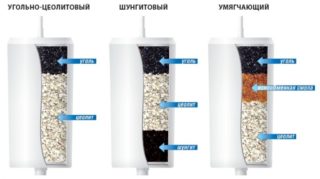 The following types of treatment plants are available on the market:
The following types of treatment plants are available on the market:
- Flowing. The simplest and most unpretentious filter. It is mounted directly on the crane. Its capacity is approximately one glass / minute.
- Sorption. It is a polymer flask with coal filling. On sale there are hollow cartridges in which you can pour filter layers of your choice, and ready-made cartridges. Such high-grade carbon cartridges for water purification filters are used in Aquafor or Barrier jugs.
- Stationary installations. The most complex, expensive and at the same time effective. Water after treatment with such a filter is fed to a separate tap. An example of such coal systems is the Geyser installation.
Each of the systems fully copes with its task, but requires regular maintenance - replacing the adsorbent backfill or cartridges.
Criterias of choice
Carbon filters for the home should be selected according to the following criteria:
- The estimated volume of the processed medium. For the preparation of drinking water for a family of 3-5 people, a flow-type device will not be enough. And for the summer cottage, operated in the summer season - that’s it.
- The level of contamination of the medium. If it's just tap water, it’s more profitable to put a regular jug. If it is a water supply from a well or a well, it is better to mount a full-fledged installation under the sink with a separate tap.
- The size of the granules of coal filling. The smaller it is, the faster the layer will clog. Moreover, the better it cleans the liquid from suspensions and dissolved impurities.
- Type of backfill. Its various variations are aimed at combating impurities of iron and chlorine, increased stiffness, etc.
It will be useful to pay attention to the brand and the total cost of equipment.In addition, it is advisable to take into account the costs of maintaining the system and the availability of a service center in the region if it is planned to install a full-fledged multi-stage main filter.
Installation Features
When installing a carbon filter system, the following nuances must be taken into account:
- It is forbidden to install the equipment on the domestic hot water system and next to heating appliances. High temperatures reduce the efficiency of the adsorbent bed.
- It is not recommended to exceed the pressure in the pipeline. The optimal indicator is up to 8 atm.
- It is necessary to provide access to the installation in order to change replaceable cartridges in time.
- There should be good ventilation in the installation area of the filter system, and the humidity level cannot exceed 70%. If this indicator is greater, filter filling will not fulfill its functions.
So that small particles of coal are not present in the water, you can optionally install a coarse filter. But it is optional.
The installation of an activated carbon filter is performed as follows:
- At the base of the sink make an additional hole for the tap outlet to the treated water. You can do this with a drill. The diameter of the hole is not more than 13 mm.
- A tap is mounted in the prepared hole.
- A clamp support is installed on the drain pipe under the sink. It should be located above the water seal and coincide with the opening of the drain tube.
- It is necessary to process the thread with sealing Teflon tape and mount the drive.
- It remains to fix the valve in the tank.
The first water passed through the filter is better not to use. It is advisable to spill at least 5-7 liters of liquid through the system and only then use it for food or for drinking.
If a filter operating with a diverter is mounted, you just need to switch it to the desired position. In this case, the liquid will either go through the coal filling, or immediately flow into the water tap.
Operation and maintenance
During the operation of the carbon filter, whether it is a jug, a nozzle or a complete system, the backfill gradually becomes clogged. A replacement cartridge is required to restore the cleaning ability of the equipment. On average, the duration of a polymer flask is about 2 months. Often the manufacturer gives recommendations on the optimal period of use of the filter, depending on the volume of water passed through it. It is worth sticking to these values.
Automatic installations can work without replacement of backfill up to 2 years.
Filter cost
For water treatment with activated carbon at home, you can purchase the following installations:
- Trunk "Aquatec" - from 2 485 rubles. and higher (reverse osmosis systems from 7,000 rubles);
- jugs “Barrier” and “Aquaphor” - the price is from 350 rubles.
- Geyser systems - from 4 870 rubles.
Regardless of the method chosen for cleaning liquid with activated carbon, water that has passed all levels of adsorption filtration is suitable for safe use.
